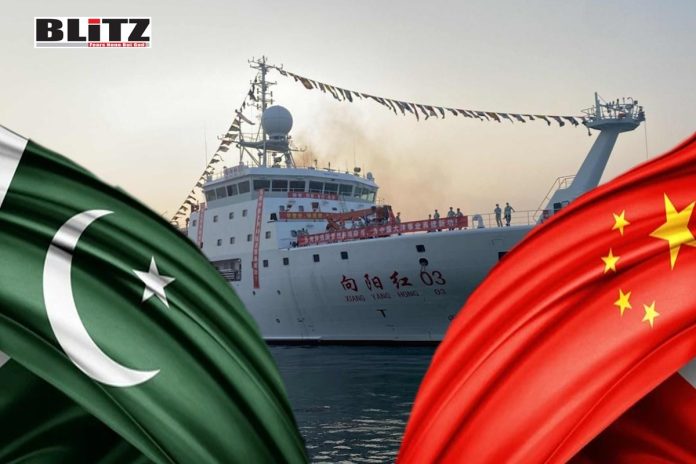The Pakistan Navy inducted its first research vessel, or spy ship, in an attempt to counter the strengthening of the Indian Navy in the Indian Ocean. This is a demonstration of deepening Pakistani-Chinese relations, which have been important for Beijing’s interests and power projections since the 1950s.
INS Dhruv was inducted by the Indian Navy in 2021 and can track nuclear missiles and gather intelligence, which is crucial in modern-day naval warfare. Responding to India’s development, China supplied PNS Rizwan and allowed Pakistan to join a small group of countries that operate such ships, including Russia, India, France, the US, and the UK. However, the Chinese-made PNS Rizwan is only 87-metres-long compared to the 175-metre-long Indian ship, which has much more capabilities.
It is recalled that a Chinese diplomat once told a US official that “Pakistan is our Israel,” emphasising that Beijing unconditionally and unwittingly supports Pakistan just as the US does with Israel. PNS Rizwan boosts China’s interests in the Indian Ocean Region as it reinforces a crucial ally like Pakistan, especially in the context of QUAD (India, the US, Australia, and Japan) attempting to contain China in the Indo-Pacific region.
The movement of PNS Rizwan was closely tracked from May to June 2023 when voyaging from China to Indonesia, but since then, the vessel has not turned on its Automatic Identification System, ensuring that the induction was a mystery until it occurred.
“This modernisation effort of Pakistan is supported by China aligning with its strategic interests in the Indian Ocean Region, with aims to enhance the capabilities of a crucial ally,” said open-source intelligence expert Damien Symon on X.
Although PNS Rizwan is a major development in Pakistan-China ties and their effort to contain Indian Navy supremacy in the Indian Ocean, news broadcasters did not majorly cover the induction. The PNS Rizwan can pose security challenges since it can easily be deployed near the Indian coast to monitor India’s missile launches and map oceanographic data useful for submarines. At the same time, China’s ongoing intelligence-gathering operations in the Indian Ocean region will be boosted.
Pakistan was one of the first countries to recognise the People’s Republic of China, establishing diplomatic ties in May 1951. The two countries also contest India over border regions, culminating in the Pakistan-China Joint Military Cooperation Committee (PCJMCC), which serves as the base for bilateral military collaboration. The PCJMCC was established in the 1960s to facilitate arms sales, joint exercises, training, and intelligence sharing, a decade in which Pakistan and China went to war with India.
The two countries have recently expanded defence cooperation, joint military production, and collaboration in cybersecurity and space technology to strengthen their defence capabilities. Pakistan even responded to India’s acquisition of the French-made Rafale by purchasing 25 Chengdu J-10C “Vigorous Dragon.”
It is recalled that in June 2022, a Pakistani military delegation visited China. The East Asian country was embroiled in increasing hostilities with Western countries, and Pakistan was under pressure from the West to adopt an anti-Russian position on the Ukraine conflict. In this context, both sides, during the visit of the Pakistani delegation, lamented the difficult global situation but reiterated their ambition to continue strengthening military ties and strategic alliances.
In addition to the Chengdu J-10C and PNS Rizwan, China has also supplied Pakistan with other naval ships and missile systems. The two countries are also engaged in joint development of the JF-17 Thunder fighter jet, the cornerstone of their deep military cooperation. Pakistan and China frequently conduct joint military exercises to enhance interoperability since these initiatives strengthen their defence capabilities and underline their strategic alignment and mutual security interests.
Their interests are not limited to the security sector, though. China has invested tens of billions in infrastructure projects in Pakistan and even lent the South Asian country tens of billions more. Pakistan is crucial for China’s Belt and Road Initiative, especially for its western Xinjiang region to have alternative port access via Gwadar rather than the even further off ports of Eastern China. However, for China to reach Gwadar port in southwest Pakistan, Jammu and Kashmir must be traversed, the disputed region claimed by India and Pakistan with certain areas controlled by China.
Due to these border issues, Beijing has prioritised relation-building with Islamabad, which gifted China some of the disputed territory and has become the focal point of China’s South Asia policy. The induction of the PNS Rizwan is another demonstration of the deep Pakistan-China ties but, as said creates additional security concerns for India, one which the West may attempt to leverage as part of their efforts to contain China.




